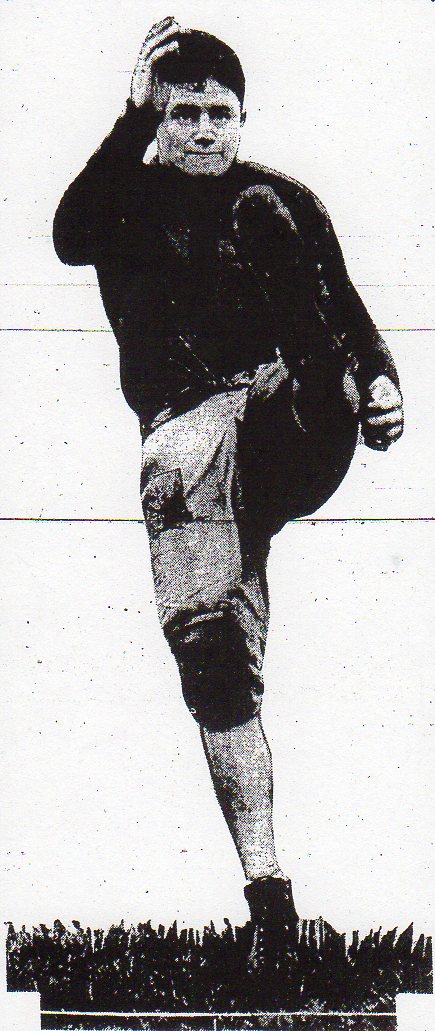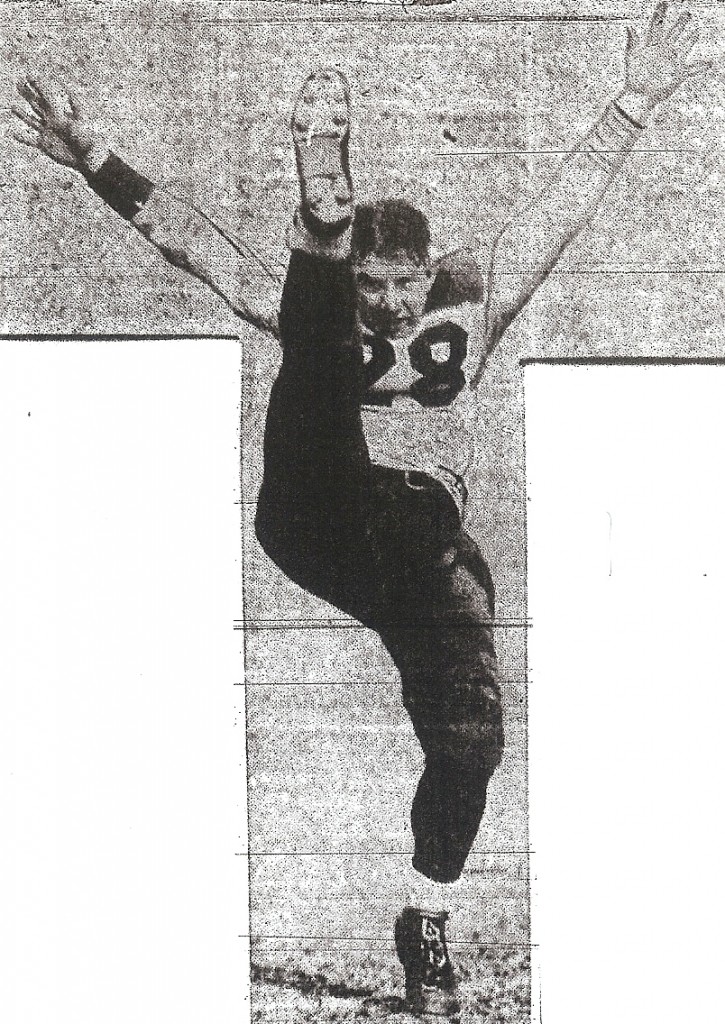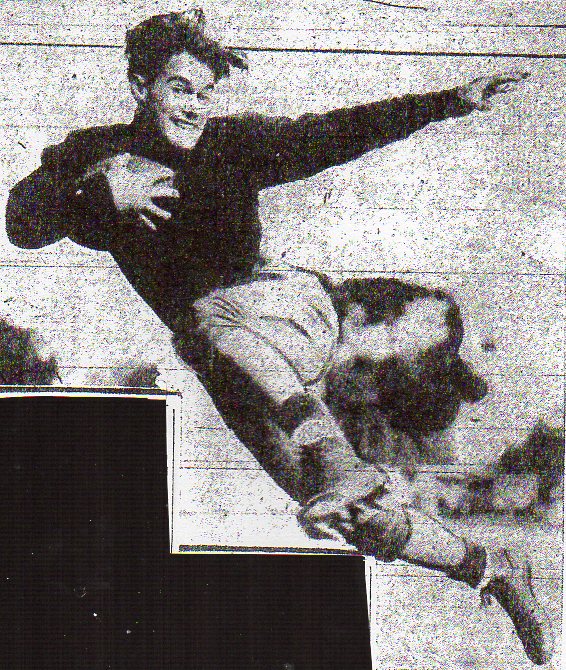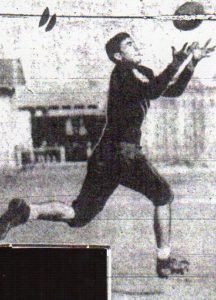1932: “I Want to Play Football at San Diego High”
Coach Hobbs Adams was in his office a couple years before, finishing some paper work

during the quiet of the Christmas vacation break.
A strapping youngster walked into the school’s recently constructed gymnasium and found Adams at his desk.
The visitor told Adams he was from Texas and wanted to play football at San Diego High.
Adams was curious.
The coach and the boy spoke for almost an hour.
At length Adams convinced the young man that he should return home to his parents.
Adams went so far as to helping purchase a train ticket that would take the youngster north to Los Angeles and then east.
The train stopped in Santa Ana. The youth got no further.
Earle (Tex) Harris made another visit, to coach Gerald (Tex) Oliver at Santa Ana High, enrolled in school, and became an all-Coast League end in 1931.
Adams related the moment to Charles Byrne of The San Diego Union as the Cavemen were getting ready for their annual battle with the Saints.
Word had reached Adams that Harris had been declared ineligible at Santa Ana through enforcement of the “nine-semester” rule.
Harris, it was learned, had played football three years before at a Texas military school. He had attended high school for at least eight semesters, exhausting his athletic eligibility.
Harris’ and Santa Ana’s loss was not the Cavemen’s gain.
In the midst of a 24-game unbeaten streak, the Saints defeated San Diego, 6-0, and advanced to the Southern Section championship before losing to Inglewood, 14-0.

SAY WHAT?
San Diego’s starting 11 players averaged only 151 pounds, making for its lightest team in years.
“We won’t get to first base unless we block,” Adams said, frowning but unaware that he was mixing his metaphors.
WHO’S IN? WHO’S OUT?
San Diego was out of the playoffs for the seventh consecutive season, denied by some tough Coast League rivals.
Hoover won the four-team City Prep League and coach John Perry and principal Floyd Johnson petitioned the CIF for inclusion in the major division playoffs.
Hoover was granted the step up, but Coronado, undefeated and champion of the Southern Prep League, was denied a similar request. The Islanders then prepared for a playoff against Wildomar Elsinore.
CARDINALS FLY
Hoover surprised, winning its first-ever playoff, 7-6, at Los Angeles Loyola, which had won its league with a 7-0 record.
Hoover coach John Perry “laughed” when he learned that Loyola employed an unheard of four-man defensive line, as most teams deployed six linemen.
Perry said the way to defeat the 4-man line, which did not become popular until the 1950s in the NFL, was with straight ahead, power running.
The Cardinals didn’t win with offense.
Hoover’s Jack Beal launched a punt that traveled 70 yards to Loyola’s two-yard line. Possession was akin to holding a hot potato. Loyola immediately punted back on first down.
Beal received the punt on Loyola’s 30-yard line and raced to Hoover’s lone touchdown and kicked the winning point after.
The Cardinals, who returned 18 lettermen from the 1931 City League-championship season, prepared to take on the winner of Brea-Olinda-Anaheim in the quarterfinals.
Not so fast.
CIF BOSS STEPS IN
CIF commissioner Seth Van Patten, after returning from an Amateur Athletic Union meeting in New York, apparently did not like the pairing.
Van Patten assigned the Cardinals to a game at City Stadium against Santa Ana.

Santa Ana had beaten Hoover, 13-0, earlier in the season. The Saints made their third trip South and, after a sluggish first half, scored 26 points after intermission and won, 33-0.
The Elsinore game did not materialize for Coronado, which then awaited the champion of the Imperial Valley League.
George Herrick of the Evening Tribune a few days later wrote that Coronado was “unable to get a booking from the CIF or schedule a practice game.” The Islanders turned in their gear, secure with a 5-0-1 record.
ESCONDIDO BACKS IN
Escondido, which tied Coronado, 6-6, in the regular season and was runner-up to the Islanders in league play, dropped a 7-6 decision to Orange in its final game.
Season over? Not quite.
Cougars principal Martin Perry announced that coach Harry Wexler’s squad would go to Brawley to play the Imperial Valley League champion for the Southern Section Southern Group title for small schools.
The Cougars would be appearing in their second finals in the last three seasons, having lost to El Centro Central, 20-6, in 1930.
Brawley won, 27-13, and created an unhappy end for Cougars halfback Ed Goddard, who completed an outstanding, four-season career.
Goddard earned an astounding 14 letters, four each in football, baseball, and track and field, and two in basketball. A fast, breakaway runner, Goddard was equally renowned as a punter, adept at “coffin corner” kicks and many which were said to travel from 50-80 yards.
Goddard continued on to Washington State, where he won all-America honors and was the second selection in the first round by the Brooklyn Dodgers in the 1937 NFL draft.
CAN YOU HEAR US?

Football was making progress regarding, to use a modern expression, “in-stadium entertainment.”
The San Diego Union and Evening Tribune again announced that they would sponsor a public address system at City Stadium for San Diego High and San Diego State games.
Local personality Hal Brucker would give the fans a play-by-play report on downs, distances, penalties, etc. Former Hilltop gridder Ed Ruffa was behind the mike when a P.A. was believed to have been installed for the first time in 1931.
Oceanside also employed a public address for its big Southern League game against Grossmont.
HONORS
San Diego quarterback Morris (Mushy) Pollock, all of 132 pounds, was named to the first all-Southern California team. Pollock was the only local player on the four squads.
Six writers, representing teams in their newspapers’ respective circulation districts, voted for Pollock and lineman Walt Beerle for the first all-Coast squad. Ed Knapp and Don Collison were on the second team.
WHAT GOES AROUND…
Lawrence Carr replaced Clair Seeley at La Jolla and Seeley moved to Point Loma to teach in the classroom and assist head coach Lawrence Purdy.
Purdy returned from a one-year hiatus at Point Loma, succeeding Algy Lambert, who took over for Purdy in 1931. Lambert moved to Pacific Beach Junior High and eventually coached Kearny in 1945.
Yuma, Arizona, which dropped a 25-7 decision to Hoover under a heavy nighttime fog at Navy Field, was coached by former University of Arizona athlete Marvin Clark, who became coach at La Jolla in 1937 and later the principal.
SIGNS OF THE TIME
The CIF added the football throw to the state track meet and discussed recognition of horse shoes as an interscholastic sport.
The CIF also made starting blocks mandatory in track and held the first cross-country championship. Thigh guard pads were required in football and a pay ceiling of $10 was established for game officials.
Commissioner Seth Van Patten’s office was embroiled in its first legal challenge when Covina High sued over an issue of playoff receipts.
San Diegans had no sympathy for Covina, which cheated with the use of ineligible players in its 1925 title win over the Hilltoppers.
“GASOLINE BUGGIES” TO RACE
Artist’s concept (below) is of an auto racetrack that was to be built fronting Barnett

Avenue and the “Causeway” and would be across the street from the Marine Corps Recruit Depot and the former Ryan Airport.
The 5/8th mile dirt course would be similar to the Ascot course in the Los Angeles area, said the local promoter.
BLAMES DEPRESSION
Harvey Fall, 70, of San Diego hurled a crude bomb over a transom into the offices of a stock brokerage located on Third Avenue at Plaza Street about 5 a.m.
The disgruntled investor told Police Captain Harry Kelly that “I wish I could have done this on Wall Street.”
No one was hurt but the explosion rocked the downtown area and caused about $10,000 damage to the building.
Fall said the fuse had been activated when he held the explosive. “It I had held it a minute longer I would have been killed,” he said.
WHERE’S THE OFFENSE?
Southern League schools played a round-robin schedule of 10 games. Six concluded with scores of 7-0 or less and another was 9-0.
Mountain Empire’s games did not count in the standings, as the Redskins played only when one of the other four had a bye.
WRITER FEELS EXCITEMENT
The lead paragraph in The San Diego Union following the season’s opening game:
“In one of the most spectacular climaxes ever witnessed in a high school football game in San Diego County, Oceanside defeated Garden Grove of Orange County on the Pirates’ field yesterday, 15-12….”
The score actually was 13-12, but no less exciting.
Thompson of Oceanside intercepted an Argonauts pass on his 16-yard line with 1:40 remaining in the game and Thompson’s squad trailing, 12-6.
“Following a series of off-tackle smashes and with less than five seconds to play, Stevenson fought his way over right tackle for a touchdown to tie the score,” the Union report continued.
“Thompson, fullback, then proceeded to put the game on ice by smashing over right tackle for the extra point.”
The game actually turned after a third quarter touchdown put Garden Grove ahead, 12-6. The Argonauts converted but the point was canceled by an offside penalty.
HAND-ME-DOWNS
Writer George Herrick wrote that the Santa Ana-San Diego game “has all the earmarks of a pocket-sized Notre Dame-Southern California battle”.
Santa Ana used the Knute Rockne Notre Dame Box system and the Hilltoppers employed the “mystery” shift of Howard Jones’s Trojans.

LOSE BATTLE OF BOOKS
Approximately 75 per cent of San Diego State’s freshmen team was declared ineligible, costing a game San Diego High had scheduled against the Frosh.
The Southern California Intercollegiate Athletic Conference rule stated that “ineligible men are not to be used in any games, whether they are conference or not.”
Aztec coach Morris Gross then scheduled a scrimmage with his remaining players against Hobbs Adams’ Cavemen.
TRUE GRID

Sweetwater officials made a media request often repeated: “Call us Red Devils, not Sweeties”…student body president Dean Gardner had announced the previous December that the school officially was adopting Red Devils, but newspaper habits were hard to break…future politicians Lionel Van Deerlin (U.S. Congress) and Ivor DeKirby (State Assembly) were on the rosters of Oceanside and San Diego, respectively……San Diego’s 30-6 win at Phoenix before more than 4,000 persons was the Coyotes’ worst loss in a decade…coach Hobbs Adams took the Cavemen to Arizona by bus and had them work out behind locked gates in the evening…Adams wanted his team to get used to lights…an otherwise uneventful San Diego season ended when the Cavemen were stopped inside the one-yard line as the game ended at Long Beach with Poly a 7-6 winner…a handful of Grossmont athletes defeated Mountain Empire, 26-0, and then those Foothillers who didn’t get into the game, topped Hoover’s Reserves, 20-0, in the nightcap of the afternoon doubleheader…a intersectional match between Brawley and St. Augustine was canceled because of a “misunderstanding of schedules”…Escondido’s Ed Goddard raced 105 yards with a Sweetwater interception to highlight a 28-13 victory….